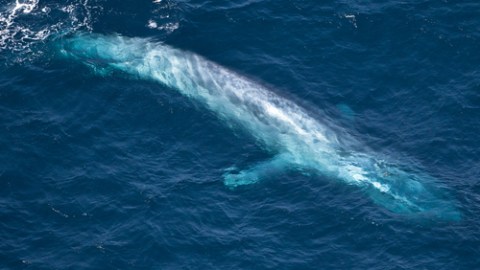The Silence of the Whales

This post originally appeared in the Newton blog at RealClearScience.
Imagine a blue whale.
Drifting in the deep, the hulking, yet streamlined mammoth unleashes a string of sound, a booming, but delicate song.
Since their ancestors originally crawled into the oceans some fifty million years ago, whales have had millions of years to evolve and perfect their astounding voices. Emitting sound at a very low frequency of around 20 hertz, blue, fin, humpback and minke whales aren’t merely able to communicate across hundreds of meters like a shouting human, but all the way across vast oceans.
The first man to figure this out was Roger Payne. A marine biologist, he was also first to discover and document the songs of humpback whales. He calculated that at low frequencies in the deep ocean, where sound is scarcely absorbed, two whales could communicate with each other pretty much anywhere in the world!
“For most of their history, whales may have established a global communications network,” Carl Sagan stated in Cosmos.
But since the 1900s, this network has started to unravel. With the advent of the steamship and other loud naval propulsion systems, humans have polluted the oceans with mindless, maddening noise. Now, instead of being able to extend for thousands of kilometers, whales’ voices can only carry across a few hundred before they are lost amidst the din of propellers, explosions, and sonar.
“Do whales know each other’s names? Can they recognize each other as individuals by sounds alone?” Sagan wondered. “We have cut the whales off from themselves. Creatures that have communicated for tens of millions of years have now effectively been silenced.”
Worse, when Carl Sagan wrote those somber words, many whale species were on the brink of extinction. The blue whale, the largest mammal to ever exist, had been reduced in population toless than 10,000 individuals, down from a citizenry that may have exceeded 250,000. Thankfully, a 1986 ban on commercial whaling began to reverse this distressing course, and today, many whale species have mostly recovered from near annihilation.
Now that we’ve slowed the systematic killing of whales, perhaps we should also allow them to speak. We can’t restrict commercial shipping or boating altogether, chief causes of noise pollution, but we can, to an extent, alter trade routes to steer vessels away from whale populations. Ships can also install quiet propellers and add sound-absorbing tiles to their hulls to drown out the racket of whirring engines.
And while we work on permitting whales to fully communicate with each other once again, perhaps we, ourselves, can also listen in more closely. Big-brained and social, whales areundeniably intelligent, maybe even more so than the great apes. What’s more, they may already be attempting to communicate with us. Last year, researchers at the National Marine Mammal Foundation in California described the efforts of NOC, a teenage white whale, to mimic human speech. Was he trying to talk to his trainers?
“Our observations suggest that the whale had to modify its vocal mechanics in order to make the speech-like sounds. Such obvious effort suggests motivation for contact,” they told theTelegraph.
As Carl Sagan made clear, humans certainly have motivation to make contact.
“We humans, as a species, are interested in communication with extraterrestrial intelligence. Would not a good beginning be improved communication with terrestrial intelligence… with those intelligent masters of the deep, the great whales?”
Primary Source:Cosmos, by Carl Sagan
(Image: Blue Whale via Shutterstock)





